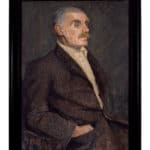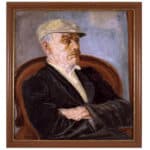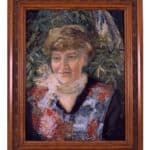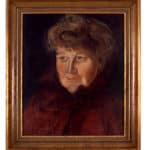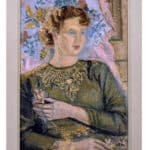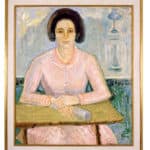Edith Holmes was born in Hamilton, Tasmania in 1893. While spending the majority of her life living in Moonah, Hobart, Holmes grew up in Devonport as the third of five children. Both of her parents were teachers; her father William N. Holmes a schoolmaster from Ireland and her mother Lilla Edith Homes a Tasmanian-born school teacher. Edith’s father had abilities in calligraphy and drawing, and Edith also showed an interest in art from an early age. It has been suggested that her first painting tutor may have been Annie Cocker, who is also represented in the DCC Permanent Collection.
Holmes later continued her art studies at the Hobart Technical College, where she completed a year-long course titled ‘Still Life Oil Painting’ in 1918. From 1930 to 1931, she studied at the Julian Ashton School of Arts in Sydney, alongside George Lambert and Thea Proctor. During the 1950s and 60s, Holmes travelled overseas, where she was exposed to new artistic influences. She would paint throughout her life, from her first documented work Still life with strawberries (1906), continuing into the early 1970s, shortly before her death. As well as notable artist, Holmes was widely recognised as a philanthropist and environmentalist.
The DCC Permanent Collection holds nine works by Holmes, seven of which are portraits. While painting across portraiture, landscape and still life, in her later years Holmes focused more on portraiture. It is undoubtedly her portraits for which she is best known, and over the years Holmes’ paintings were included in eight Archibald Prize exhibitions.
Portraits from the DCC Permanent Collection:
LEFT: Edith HOLMES, William Lassan Holmes (c1930s), oil on canvas board, RIGHT: Edith HOLMES, William N. Holmes Esq. (c1936-40), oil on canvas board
William Holmes, depicted in the two paintings above, was Edith’s father. The portrait on the left was included in the 1935 Archibald Prize, the first of the artist’s works to be accepted into the exhibition. William Holmes was a school teacher, who migrated to Tasmania in 1881, and he was known as a strong athlete, particularly in cricket. This portrait was displayed in the dining room of the family home Dilkhoosha, where Edith usually painted.
LEFT: Edith HOLMES, Mother (c1936), oil on canvas board, RIGHT: Edith HOLMES, Mrs Lilla Edith Holmes (1947-51), oil on canvas board
There are four known portraits that Edith painted of her mother, Lilla Edith Holmes, three of which survive, and two of which (above) are held in the DCC Permanent Collection. Edith’s mother had five children including Edith, and worked with her husband William as an assistant teacher. She was said to have a keen sense of colour, and to be very supportive of Edith’s artistic pursuits.
LEFT: Edith HOLMES, Joan (1952), oil on canvas board, RIGHT: Edith HOLMES, Patsy Adam Smith; OBE, AO (c.1960-69), oil painting
Joan Dabrowski, depicted in the portrait on the left, was Edith’s niece. Joan’s mother died when she was young, and following her death Joan spent a substantial amount of time with Edith either at Dilkhoosha, or out sketching, and the two remained close in the later years of Edith’s life. Patsy Adam Smith (1924-2001), depicted in the portrait on the right, was a celebrated author who grew up in regional Victoria, and would at times stay in Hobart while working as a trading vessel radio operator.
Holmes’ portraits were almost always painted at Dilkhoosha, her Moonah home, where until 1940 she primarily worked in a garden shed. Later, after the death of her father, she would work primarily in the home’s drawing room. Often these portraits, including those held in the DCC Permanent Collection, were of her family and friends, with Holmes stating that she sought to ‘convey their character in her art.’
-Erin Wilson, Curator
View more works from the DCC Permanent Collection here
